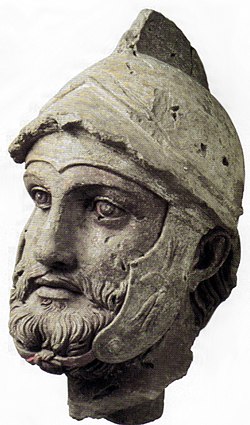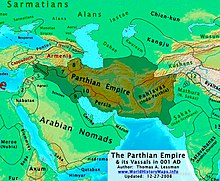Roman–Parthian Wars
| Roman–Parthian Wars | |||||||||
|---|---|---|---|---|---|---|---|---|---|
| Part of the Roman–Persian Wars | |||||||||
| |||||||||
| Belligerents | |||||||||
| Roman Republic, succeeded by Roman Empire and client states | Parthian Empire and clients | ||||||||
| Commanders and leaders | |||||||||
|
Surena Orodes II Pacorus I † Phraates IV Artabanus III Vologases I Tiridates I of Armenia Osroes I Sinatruces II † Vologases IV | |||||||||
The Roman–Parthian Wars (54 BC – 217 AD) were a series of conflicts between the Parthian Empire and the Roman Republic and Roman Empire. It was the first series of conflicts in what would be 682 years of Roman–Persian Wars.
Battles between the
In 113 AD, the Roman Emperor
In 195, another Roman invasion of Mesopotamia began under the Emperor
Parthia's western ambitions
After triumphing in the Seleucid–Parthian Wars and annexing large amounts of the Seleucid Empire, the Parthians began to look west for more territory to expand into. Parthian enterprise in the West began in the time of Mithridates I; during his reign, the Arsacids succeeded in extending their rule into Armenia and Mesopotamia. This was the beginning of an "international role" for the Parthian empire, a phase that also entailed contacts with Rome.[4] Mithridates II conducted unsuccessful negotiations with Sulla for a Roman–Parthian alliance (c. 105 BC).[5][verification needed]
By the same time the Parthians started their rise, they established eponymous branches in the Caucasus, namely the Arsacid dynasty of Armenia, the Arsacid dynasty of Iberia, and the Arsacid dynasty of Caucasian Albania.
After 90 BC, the Parthian power was diminished by dynastic feuds, while at the same time, Roman power in Anatolia collapsed. Roman–Parthian contact was restored when Lucullus invaded Southern Armenia and defeated Tigranes in 69 BC, however, again no definite agreement was made.[6]
Roman Republic vs Parthia

When
Battle of Carrhae (53 BCE)
In 53 BC,
The following year, the Parthians launched raids into Syria, and in 51 BC mounted a major invasion led by the crown prince
Caesar's plans (45–44 BCE)
During

Pompeian–Parthian invasion (40–38 BCE)
After that defeat, the Parthians under Pacorus invaded Roman territory in 40 BC in conjunction with
Antony's Atropatene campaign (36 BCE)
Meanwhile,
With Roman control of
Roman Empire vs Parthia
Tensions over Armenia
Under the threat of an impending war between the two powers,
The decision of the Parthian king Artabanus II to place his son, Arsaces, on the vacant Armenian throne nearly led to a war with Rome in 36 AD. Artabanus III reached an understanding with the Roman general,
War of the Armenian Succession (58–63)
A new crisis was triggered in 58, when the Romans invaded Armenia after the Parthian king
Armenia would henceforth be ruled by a Parthian dynasty, and despite its nominal allegiance to Rome, it would come under increasing Parthian influence. In the judgment of later generations, "Romans had lost Armenia", and although the Peace of Rhandeia ushered in a period of relatively peaceful relations that would last for 50 years, Armenia would continue to be a constant bone of contention between the Romans, the Parthians, and their Sassanid successors.
As for Corbulo, he was honored by Nero as the man who had brought this "triumph" to be, but his popularity and influence with the army made him a potential rival. Together with the involvement of his son-in-law
Trajan's Parthian campaign (115–117)

A new series of wars began in the 2nd century, during which the Romans consistently held the upper hand over Parthia. In 113, the Roman Emperor Trajan decided that the moment was ripe to resolve the "eastern question" once and for all time by the decisive defeat of Parthia and the annexation of Armenia; his conquests marked a deliberate change of Roman policy towards Parthia, and a shift of emphasis in the "grand strategy" of the empire.[3]
In 114, Trajan invaded Armenia, annexed it as a Roman province, and killed
Hadrian's policy and later wars
Trajan's successor, Hadrian, promptly reversed his predecessor's policy. He decided that it was in Rome's interest to re-establish the Euphrates as the limit of its direct control, and willingly returned to the status quo ante, surrendering the territories of Armenia, Mesopotamia, and Adiabene back to their previous rulers and client-kings. Once again, at least for another half century, Rome was to avoid active intervention east of the Euphrates.[19]
War over Armenia broke out again in 161, when

In 195, another Roman invasion of Mesopotamia began under the Emperor
Rise of the Sassanids
Parthia was finally destroyed by Ardashir I when he entered Ctesiphon in 226. The Sassanids were more centralized than the Parthian dynasties. Until the
See also
- List of Parthian kings
- List of Roman consuls
Citations
- ISBN 978-18-4511-406-0. Retrieved 2019-06-09.
- ^ a b Bivar (1968), 57
- ^ a b Lightfoot (1990), 115: "Trajan succeeded in acquiring territory in these lands with a view to annexation, something which had not seriously been attempted before [...] Although Hadrian abandoned all of Trajan's conquests [...] the trend was not to be reversed. Further wars of annexation followed under Lucius Verus and Septimius Severus."; Sicker (2000), 167–168
- ^ Beate-Engelbert (2007), 9
- ^ Plutarch, Sulla, 5. 3–6
* Sherwin-White (1994), 262 - ^ Sherwin-White (1994), 262–263
- ^ Sherwin-White (1994), 264
- ^ Mackay (2004), 150
- ^ Alfred John Church, Roman Life in the Days of Cicero, (Kindle edition) ch. XIII., loc. 1845
- ^ Bivar (1968), 56
- ^ Bivar (1968), 56–57
- ^ Bivar (1968), 57–58
- ^ Cassius Dio, Roman History, XLIX, 27–33
* Bivar (1968), 58–65 - ^ Sicker (2000), 162
- ^ Sicker (2000), 162–163
- ^ Sicker (2000), 163
- ^ Rawlinson (2007), 286–287
- ^ a b Sicker (2000), 167
- ^ a b Sicker (2000), 167–168
- ^ a b Sheldon, Rose Mary (2010). Rome's Wars in Parthia: Blood in the Sand. London: Vallentine Mitchell. p. 143.
- ^ Sicker (2000), 169
- ^ Campbell (2005), 6–7; Rawlinson (2007), 337–338
- ^ Cowan, Ross (2009). "The Battle of Nisibis, AD 217". Ancient Warfare. 3 (5): 29–35. Archived from the original on 2016-04-29.
References
Primary Sources
- Cassius Dio, Roman History. Book LXXX. Translated by Earnest Cary.
 Plutarch, Sulla. Translated by John Dryden.
Plutarch, Sulla. Translated by John Dryden.
Secondary sources
- Beate, Dignas; Winter, Engelbert (2007). Rome and Persia in Late Antiquity. Neighbours and Rivals. Cambridge University Press. ISBN 978-3-515-09052-0.
- Bivar, A.D.H (1983). "The Political History of Iran under the Arsacids". In ISBN 0-521-20092-X.
- Campbell, Brian (2005). "The Severan Dynasty". In ISBN 9780521301992.
- Lightfoot, C.S. (1990). "Trajan's Parthian War and the Fourth-Century Perspective". The Journal of Roman Studies. 80. Society for the Promotion of Roman Studies: 115–116. S2CID 162863957.
- Mackay, Christopher S. (2004). "Caesar and the End of Republican Government". Ancient Rome: A Military and Political History. Cambridge University Press. ISBN 0-521-80918-5.
- ISBN 978-1-60206-136-1.
- ISBN 9780521256032.
- Sicker, Martin (2000). "The Struggle over the Euphrates Frontier". The Pre-Islamic Middle East. Greenwood Publishing Group. ISBN 0-275-96890-1.
External links
![]() Media related to Parthian-Roman wars at Wikimedia Commons
Media related to Parthian-Roman wars at Wikimedia Commons
